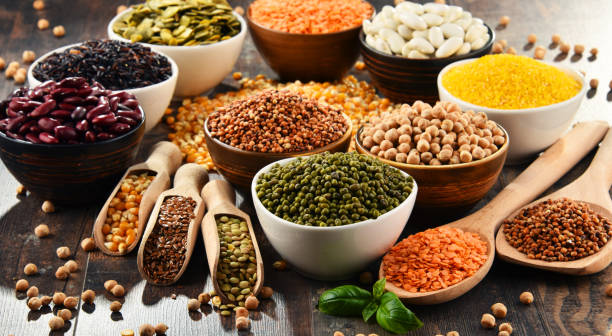Cereals and pulses are essential components of a balanced diet, providing vital nutrients to millions of people worldwide. While cereals serve as the primary source of carbohydrates, pulses offer high protein content, making them a perfect complement to each other in daily meals.
What Are Cereals?
Cereals are edible grains obtained from grass-like plants belonging to the Poaceae family. They are a rich source of carbohydrates, which provide the body with energy. Common cereals include:
- Rice – A staple in many Asian countries, rich in carbohydrates and easy to digest.
- Wheat – Widely used for making bread, pasta, and other baked goods, rich in fiber and B vitamins.
- Maize (Corn) – Consumed as a vegetable or grain, it is an excellent source of fiber and antioxidants.
- Barley – Used in soups, bread, and brewing, it is packed with fiber and essential minerals.
- Oats – Popular as a breakfast cereal, oats contain beta-glucan, which helps lower cholesterol levels.
- Millets – These include sorghum, ragi, and foxtail millet, which are gluten-free and rich in micronutrients.
Nutritional Benefits of Cereals
Cereals provide essential nutrients such as:
- Carbohydrates – The primary energy source for the body.
- Proteins – Though in small amounts, they support muscle growth and repair.
- Dietary Fiber – Helps in digestion and prevents constipation.
- Vitamins and Minerals – Such as iron, magnesium, and B vitamins for overall health.
What Are Pulses?
Pulses are edible seeds from the legume family, known for their high protein content. They are often referred to as "poor man's meat" because they are a rich source of plant-based protein. Some commonly consumed pulses include:
- Lentils (Masoor, Moong, Urad, and Toor dal) – Rich in protein and iron, they are used in soups and curries.
- Chickpeas (Kabuli and Desi Chana) – High in fiber and protein, often used in salads and hummus.
- Kidney Beans (Rajma) – A great source of protein, fiber, and antioxidants.
- Black Gram (Urad Dal) – Used in making dal, idlis, and dosas, it is a protein-rich pulse.
- Green Peas – Contains fiber, vitamins, and minerals, often used in soups and curries.
Nutritional Benefits of Pulses
Pulses provide several health benefits, including:
- High Protein Content – Essential for muscle repair and body growth.
- Rich in Fiber – Aids digestion and regulates blood sugar levels.
- Low in Fat – Ideal for weight management and heart health.
- Rich in Iron and Folate – Helps prevent anemia and supports brain health.
Cereals and Pulses: A Perfect Combination
Combining cereals and pulses in meals ensures a balanced intake of essential amino acids. For example, eating rice with lentils (dal) or wheat with chickpeas provides a complete protein profile, making it a perfect diet for vegetarians and vegans.
Conclusion
Cereals and pulses are fundamental food sources that provide essential nutrients for a healthy lifestyle. While cereals offer energy and fiber, pulses contribute high protein and minerals. Including a variety of cereals and pulses in your daily diet ensures better nutrition, promoting overall well-being.





